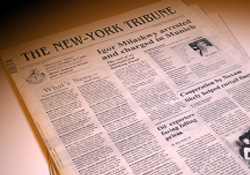Your Marketing Toolbox: Public Relations
This series breaks down different marketing tactics to help you determine which ones will best support your marketing strategy.

Public relations is a powerful and inexpensive way to reach your target audience.
Historian Daniel J. Boorstin once said: “Some are born great, some achieve greatness, and some hire public relations officers.” It’s clever, but not entirely accurate. The truth is the greatest product or service won’t sell if no one knows about it.
Generally speaking, public relations (aka PR) refers to the strategic placement of news and articles in media that are popular with your target audience, such as newspapers and magazines or television and radio programs. Its purpose is to increase awareness, educate, inform and influence public perceptions about your product, service or business. The increased awareness and positive perceptions should result in additional sales, but not in a direct way, as with advertising where you purchase media space to promote your message.
But PR also includes a variety of non-media activities aimed at raising your profile, like newsletters, speaking engagements, charitable activities and special events. For instance, I’ve had clients successfully position themselves as experts in their field by speaking at trade shows and conferences, as well as teaching workshops.
So should your business incorporate public relations as part of its marketing strategy? Let’s weigh its strengths and weaknesses.
Pros of Public Relations
What makes PR messages so powerful? When a story, article or announcement about your business appears in the media – which is perceived as an independent third party – it implies a subtle endorsement. In this way you gain credibility in the eyes of consumers.
Is this media manipulation? Not at all, so long as your topic is sufficiently newsworthy. In fact, media outlets and influencers (like popular blogs) are always looking for leads to help them produce interesting, timely stories. PR helps to fill that need.
And PR is relatively inexpensive compared to other forms of marketing, especially advertising. When your budget’s on the low end but you still need to reach a broad audience, PR is a great way to go. This could explain why spending on public relations and related services continues to climb, according to a number of studies. With the right person on staff, it can even be handled effectively in-house.
Even better, public relations material like polls and top-ten tips can be recycled and reused in various formats, squeezing even more from your investment.
Cons of Public Relations
One downside of PR is that you can’t control the message once the media chooses to run it. You can’t predict when a story will appear, or if it appears at all. It all depends on the timeliness of the subject, the availability of space or time, and the relationship you or your PR professional have with each editor.
And editors or producers have final say on what shape the story takes. On rare occasions, a biased editor with an axe to grind can put a negative spin on your story and depict your business in a poor light.
One more potential hurdle: If the topic of your story is time-sensitive, you’ll have to plan ahead to ensure it appears when it’s needed. Most publications schedule feature content weeks or months in advance, though they’ll usually supply an editorial calendar to guide you. (Blogs can be more flexible.)
Quick Tips for Effective PR
Sometimes it helps to have a PR professional in your corner. But if you’re ready to tackle the next campaign yourself, keep these tips in mind:
- Think like an editor. When evaluating your press release or story pitch, every editor or producer wants to know just one thing: Is this relevant and interesting to my audience? Tie your story to an industry trend, a timely event or a topical subject when possible. Conducting surveys or providing tips for readers are sure winners in getting published, while also positioning you as an expert in your field.
- Focus on hard facts. Yes, you want publicity, but you won’t get good coverage by singing your own praises. Save your sales pitch for your other marketing tactics. Stick to cold, hard facts and keep it objective, unless you’re quoting a source or writing an opinion piece.
- Polish that press release. When composing press releases, don’t be boring. Try to come up with creative headlines and intro paragraphs that really grab the reader. And mention the most important facts early – many times the headline and first paragraph are the only things an editor will read.
- Recycle your PR. Getting media coverage is just the beginning. Talk it up on your blog and social media pages. Mention it in your email newsletter. Create a “Press” page to feature it on your website. The more your name is out there, the more apt it is to be fresh in the minds of current and prospective clients.
Need more tips on marketing tactics? Read the previous post in this series:
Your Marketing Toolbox: Advertising
Image: Idea go/FreeDigitalPhotos.net
Pingback: Your Marketing Toolbox: Internet Marketing | Marketing Westchester NY | InSight Marketing of Westchester NY